December 20th Scots Book of Days. A.D. 1192 Richard the Lion Heart captured.
 December 20 – 1192 Richard the Lion Heart is captured and imprisoned by Leopold V (Duke von Babenberg) of Austria on Richard’s way home to England after signing a treaty with Saladin ending the Third crusade. While Richard’s father Henry 2nd visited Henry’s lands from Scotland to France, Richard probably stayed in England. William I of Scotland and Hugh Bigod were captured by Henry on 13 July and 25 July respectively 1173, from which Henry extracted a surrender and control of Scotland to England. After Henry died, by 1189 King Richard released Scotland and King William I of Scotland from William’s oath of subservience to (Henry and his heir) Richard in exchange for 10,000 marks. 650 years later Richard appears in connection with Robin Hood in Sir Walter Scott’s novel Ivanhoe. Statue of Richard I by Carlo Marochetti outside the Palace of Westminster
December 20 – 1192 Richard the Lion Heart is captured and imprisoned by Leopold V (Duke von Babenberg) of Austria on Richard’s way home to England after signing a treaty with Saladin ending the Third crusade. While Richard’s father Henry 2nd visited Henry’s lands from Scotland to France, Richard probably stayed in England. William I of Scotland and Hugh Bigod were captured by Henry on 13 July and 25 July respectively 1173, from which Henry extracted a surrender and control of Scotland to England. After Henry died, by 1189 King Richard released Scotland and King William I of Scotland from William’s oath of subservience to (Henry and his heir) Richard in exchange for 10,000 marks. 650 years later Richard appears in connection with Robin Hood in Sir Walter Scott’s novel Ivanhoe. Statue of Richard I by Carlo Marochetti outside the Palace of Westminster
Leopold V von BABENBERG (Duke) of Austria became 13GGF of HM George 1 (clan Stewart), 21GGF of US President James Monroe (clan Munro), 22GGF of PM Winston Churchill (clan Montgomery), 23GGF of Lady Diana Frances Spencer (Princes of Wales, clans Hamilton, Douglas, Gordon, Maxwell, Blair, Leslie, Lyon, Keith, Hay, Home, McCulloch, Montgomerie, Cochrane, Kennedy, ).
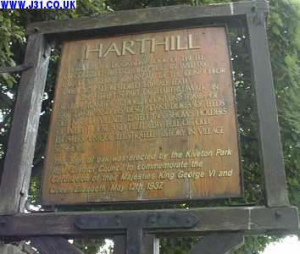 This sign hangs above the village war memorial (below), and says ‘Harthill in the Doomsday book of the Fee of Conisbro. First church built by William de Warrene son in law of the Conqueror 1078 AD restored 1310 AD.
This street is part of ‘Harthill walk’ in Scott’s Ivanhoe. Church contains tombs of Earl Danby, Duke of Leeds and some of his descendants.
Old map of village dated 1745 shows holders of every house and field very full of auld registers. Unique history in village school.
This sign of oak was erected by the Kiveton Park Rural District Council to commemorate the coronation of their majesties King George VI and Queen Elizabeth May 12th 1937.’
This sign hangs above the village war memorial (below), and says ‘Harthill in the Doomsday book of the Fee of Conisbro. First church built by William de Warrene son in law of the Conqueror 1078 AD restored 1310 AD.
This street is part of ‘Harthill walk’ in Scott’s Ivanhoe. Church contains tombs of Earl Danby, Duke of Leeds and some of his descendants.
Old map of village dated 1745 shows holders of every house and field very full of auld registers. Unique history in village school.
This sign of oak was erected by the Kiveton Park Rural District Council to commemorate the coronation of their majesties King George VI and Queen Elizabeth May 12th 1937.’
(Fabpedigree.com) William I de Warenne also known as Guillaume de Varennes, fought at Hastings with William the Conqueror, 1st Earl of Surrey, Justiciar of England, 13th Wealthiest Person ever (?) 1036-1088, wounded at Siege of Pevens Castle. Ancestor 16GGF of George 1st, 18 GGF of President George Washington, 22nd GGF of PM Churchill, 23rd GGF Pierport Hamilton, 28th GGF of Gretchen Choate (nee Luther).
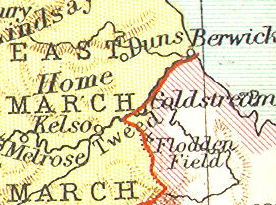 1316 Robert de Lawedre, knight, was one of the witnesses to two charters of confirmation to Jedburgh Abbey on the 20th December 1316, signed at Berwick-upon-Tweed. A church was built at Lauderdale, and by 1482, the royal favourite,
1316 Robert de Lawedre, knight, was one of the witnesses to two charters of confirmation to Jedburgh Abbey on the 20th December 1316, signed at Berwick-upon-Tweed. A church was built at Lauderdale, and by 1482, the royal favourite, 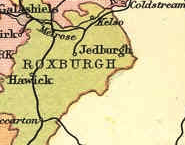 Robert Cochrane was captured and hung by chiefs including Archibald Douglas, Earl Angus, ‘bell the cat’.Map with Berwick on the Tweed river, facing the North Sea. Jedburgh is now in Roxburgh in the auld middle March.
Robert Cochrane was captured and hung by chiefs including Archibald Douglas, Earl Angus, ‘bell the cat’.Map with Berwick on the Tweed river, facing the North Sea. Jedburgh is now in Roxburgh in the auld middle March.
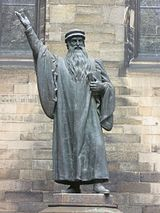 1560 The first General Assembly of the Church of Scotland was held on December 20, 1560. The assembly was treasonable and unlawful at the time according to the throne, but not among the nobility. The law was changed, by changing the throne. In 1559 John Knox returned from ministering in Geneva to lead the Reformation in Scotland
1560 The first General Assembly of the Church of Scotland was held on December 20, 1560. The assembly was treasonable and unlawful at the time according to the throne, but not among the nobility. The law was changed, by changing the throne. In 1559 John Knox returned from ministering in Geneva to lead the Reformation in Scotland
1645 sometime in December. Pestilence. Glasgow council minutes rejoice in the statement “it hath pleased God to visit the south countrie with the plague of pestilence.” Paisley that got the brunt of the plague. The baillies of Glasgow in December 1645 voted to send 20 bolls of meal (grain) and some cash to help the people of Paisley, who were short of food. Plague! By Gordon.
‘Repent, repent ye, Hear the words of that God who made you, by the voice of pestilence.’ Jesus Christ in Doctrine and Covenants section 43.
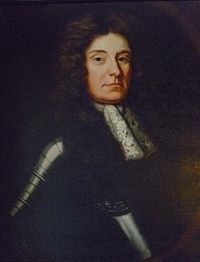 1681 9th Earl of Argyle Archibald Campbell (1629–1685) escapes from prison of Castle of Edinburgh, for test oath, of a complex and puzzling nature, and so far inconsistent with itself, that while, on the one hand, the person who took it was to profess his full belief and compliance with the Confession of Faith adopted by the Scottish Church in the first Parliament of King James VI, he was in the next clause made to acknowledge the King as supreme head of the Church ; a proposition entirely inconsistent with that very Confession which he had just recognised. (TG52-260). Sir Walter Scott.
1681 9th Earl of Argyle Archibald Campbell (1629–1685) escapes from prison of Castle of Edinburgh, for test oath, of a complex and puzzling nature, and so far inconsistent with itself, that while, on the one hand, the person who took it was to profess his full belief and compliance with the Confession of Faith adopted by the Scottish Church in the first Parliament of King James VI, he was in the next clause made to acknowledge the King as supreme head of the Church ; a proposition entirely inconsistent with that very Confession which he had just recognised. (TG52-260). Sir Walter Scott.
Campbell Earl of Argyll 1010 2Montgomery2Blair 2Cochrane2Miller 2Simmons2Choate to zoe TOAG
The Earl of Argyll. In 1650 Argyll married Lady Mary Stewart, daughter of the 4th Earl of Moray, with whom he had seven children: Archibald (who succeeded him as 10th Earl of Argyll), Charles, James, John, Mary, Anne and Jean. Argyll married again, in 1670, the widow Anne, Countess Lindsay of Balcarres. Argyll had been elected a Fellow of the Royal Society in Oct 1663.(fabpedigree.com) Archibald was 9th GGF of Lady Diana Spencer (and thus 10th GGF of William Duke of Cambridge, 11th GGF of Prince George).(clans Douglas, Graham, Gordon, Leslie, Keith, Lyon, Home, Ker, Erskine.)
- Rochester. Glorious Revolution. James II, King, resumes flight, last night in Rochester. Tytler’s Britannica 215
1694 Mary Cochrane born (b 20.12.1694, d unmarried) Ochiltree, Ayrshire.
1745 The Scottish army left Carlisle upon the 20th of December, and effected their retreat into Scotland by crossing the Esk at Langtoun; the river was swollen, but the men, wading in, arm in arm, supported 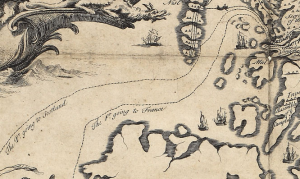 each other against the force of the current, and got safely through. [TG80-242].
each other against the force of the current, and got safely through. [TG80-242].
- Charles’ birthday [Bonnie Prince Charley]. Tytler’s Britannica 236.
Map showing ‘The Pr[ince] going to Scotland,’ and ‘The Pr[ince] going to France.’ Sailing between the Hebrides (the islands at the end of the winged dragons tongue) and Ireland (to the south, north of the Mull, landing at Lochaber, and Boradrl.
1752 Robert Millar (of Glasgow and Paisley from 1709) The Paisley presbytery register for 20 December 1752 notes Millar’s death three days before and orders it to be announced in the Abbey Church and a vacancy declared in the parish. YYMA 72. Paisley or Paisley pattern is a droplet-shaped vegetable motif of Indian or Persian origin. Its western name derives from the town of Paisley Scotland. In the 19th Century European production of paisley increased, particularly in the Scottish town from which the pattern takes its modern name. Soldiers returning from the colonies brought home cashmere wool shawls from India, and the East India Company imported more. The design was copied from the costly silk and wool Kashmir shawls and adapted first for use on handlooms, and, after 1820, on Jacquard looms. From roughly 1800 to 1850, the weavers of the town of Paisley in Renfrewshire, Scotland, became the foremost producers of these shawls. Unique additions to their handlooms and Jacquard looms permitted them to work in five colors when most weavers were producing paisley using only two. The design became known as the Paisley pattern.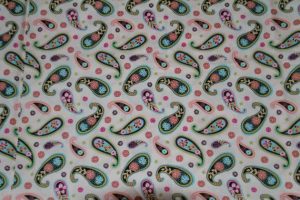 By 1860, Paisley could produce shawls with fifteen colors, which was still only a quarter of the colors in the multi-color paisleys then still being imported from Kashmir. In addition to the loom-woven fabric, Paisley became a major site for the manufacture of printed cotton and wool in the 19th Century, according to the Scotland’s Paisley Museum and Art Gallery. Paisley was particularly popular during the Summer of Love, heavily identified with psychedelic style and the interest in Indian spirituality and culture brought about by the pilgrimage of The Beatles to India in 1968. John Lennon had a Rolls Royce painted with the design in 1967, 100% cotton fabric. Marie Craig (nee Osmond) Quilting Treasures. Paisley print fabric. Etsy.com
By 1860, Paisley could produce shawls with fifteen colors, which was still only a quarter of the colors in the multi-color paisleys then still being imported from Kashmir. In addition to the loom-woven fabric, Paisley became a major site for the manufacture of printed cotton and wool in the 19th Century, according to the Scotland’s Paisley Museum and Art Gallery. Paisley was particularly popular during the Summer of Love, heavily identified with psychedelic style and the interest in Indian spirituality and culture brought about by the pilgrimage of The Beatles to India in 1968. John Lennon had a Rolls Royce painted with the design in 1967, 100% cotton fabric. Marie Craig (nee Osmond) Quilting Treasures. Paisley print fabric. Etsy.com
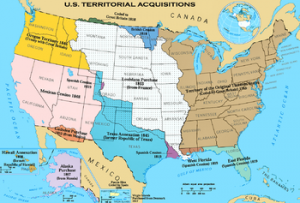 1803 France turned New Orleans over on December 20, 1803 at The Cabildo. The Louisiana Purchase Treaty was signed by Robert Livingston, Robert Livingston and Mark Choate are both decendants of Sir Alexander Livingston, who flourished under James 2nd Stewart King of Scots. (clan Livingstoun) The Purchase was one of several territorial additions to the U.S. (fabpedigree.com) Sir Alexander Livingston (died 1472) ancestor 13GGF of President Woodrow Wilson, 15th GGF of PM Winston Churchill, 16th GGF of Lady Diana Spencer (and heirs), 16th GGF PM Cameron. (clans Calendar, Menteith, Stirling, Dundas, Douglas, Stewart).
1803 France turned New Orleans over on December 20, 1803 at The Cabildo. The Louisiana Purchase Treaty was signed by Robert Livingston, Robert Livingston and Mark Choate are both decendants of Sir Alexander Livingston, who flourished under James 2nd Stewart King of Scots. (clan Livingstoun) The Purchase was one of several territorial additions to the U.S. (fabpedigree.com) Sir Alexander Livingston (died 1472) ancestor 13GGF of President Woodrow Wilson, 15th GGF of PM Winston Churchill, 16th GGF of Lady Diana Spencer (and heirs), 16th GGF PM Cameron. (clans Calendar, Menteith, Stirling, Dundas, Douglas, Stewart).
1839 The Church of Jesus Christ of Latter-day Saints, Salt Lake City, notes that the first LDS missionaries to Scotland were Canadian Scottish Saints named Samuel Mulliner and Alexander Wright. They arrived in Glasgow on December 20, 1839, and, as the new year dawned, Elder Mulliner went alone to the Paisley region to do missionary work, as Elder Wright was too ill to accompany him. “The Manuscript History of the Paisley Branch,” Church Archives.
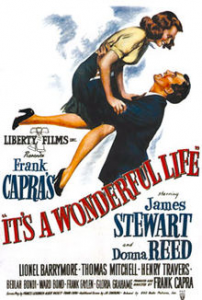 1946 It’s a Wonderful Life was nominated for five Oscars without winning any, although the film has since been recognized by the American Film Institute as one of the 100 best American films ever made and placed number one on its list of the most inspirational American films of all time.
1946 It’s a Wonderful Life was nominated for five Oscars without winning any, although the film has since been recognized by the American Film Institute as one of the 100 best American films ever made and placed number one on its list of the most inspirational American films of all time.
 Poster. James Maitland “Jimmy” Stewart 1908-1997. Brigadier General United States Air Force, American actor, Scottish descent. (clan Stewart) Features Auld Lang Syne at end.
Poster. James Maitland “Jimmy” Stewart 1908-1997. Brigadier General United States Air Force, American actor, Scottish descent. (clan Stewart) Features Auld Lang Syne at end.
1971 Mark Irvan Choate born California (12th great grand son of the Colin Campbell, 1st Earl of Argyll, 2nd Lord Campbell flourished 1457-1493.)
Campbell Earl of Argyll 1010 2Montgomery2Blair 2Cochrane2Miller 2Simmons2Choate to zoe TOAG
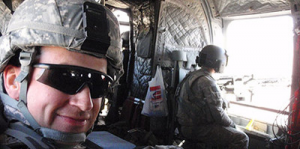 The Fourth of July celebrations mean so much more to one BYU history professor who spent the past school year among people in the process of having their freedom restored.
The Fourth of July celebrations mean so much more to one BYU history professor who spent the past school year among people in the process of having their freedom restored.
Called up by the Army Reserves 2011, Major Mark Choate left his classroom at BYU to serve for eight months as a historian for U.S. Special Operations Forces.
Choate traveled by air and ground to rural villages in 14 provinces of Afghanistan to observe the transition to self-governance. Based on his interviews with more than 300 U.S. and coalition personnel, he wrote a handbook for village stability operations. On his way home, the military awarded him the Bronze Star during a ceremony at Special Operations Command. “The U.S military treats history as a very important part of learning and commemorating and improving upon what has happened in the global war on terrorism,” Choate said.
Though his handbook remains classified, Choate points out that democracy isn’t foreign to Afghans. Prior to the Soviet invasion, villages had a long tradition of making decisions through local councils called shuras. Not surprising, stability in the rural villages is best achieved when the NATO efforts help revive and empower that culture of local councils.
“Afghanistan was fairly stable for thousands of years up until the Soviet invasion and totalitarian regime,” Choate said. “The fabric of Afghanistan is still there. Building upon local shuras and regional development holds the promise of a stable Afghanistan in the future without a continuing coalition operation.”
Choate recalls attending one shura that was interrupted by the ringing of a cell phone. The disturbance was welcomed with smiles because it meant that the cell phone service — which had been disrupted in the past by the Taliban — was now back online.
Choate’s travels also brought him to parts of the country that only days earlier had finally been cleared of Taliban fighters. In one valley along the Helmand River, the road had been in disrepair for more than five years. As soon as the coalition’s “A Team” made repairs, Choate witnessed an instant flood of traffic pour in from throughout the valley.
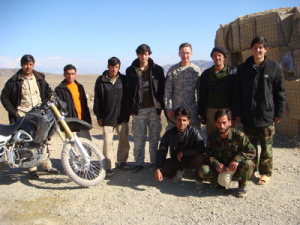 “The liberation of the valley was like a scene from the liberation of France,” Choate said. “People coming out from the villages to thank the Special Forces, and then the trade and economic development and the exchange of ideas that followed, were just exciting to see.”
“The liberation of the valley was like a scene from the liberation of France,” Choate said. “People coming out from the villages to thank the Special Forces, and then the trade and economic development and the exchange of ideas that followed, were just exciting to see.”
Choate is in only one in the Army uniform, standing third from the right.
Choate enlisted in the Army National Guard at age 17 while at Yale College and then switched to the Army Reserves before finishing his M.A., M. Phil, and Ph.D. in history from Yale. He joined the history faculty at BYU in 2001 and actually crossed paths in Afghanistan with a former student serving as a convoy commander.
“I bring back to my students the idea that world history has not ended,” Choate said. “We can still contribute; we can still be a part of history.” This 4th of July, Choate is grateful to be reunited with his family on the home front. “I have always been patriotic, but now I have a deeper appreciation for the price of freedom,” he said. “Our special operations forces are sacrificing and accomplishing so much to help our Afghan allies in their own battle for independence.”
(clans MacAlan 1317, Macdonald Earl of Ross Lord of the Isles1440, Macdonald of Galloway 1250, Macgilivrail Macgillivray 1180, Mar Earl of Mar 1330, Martin GAL, Maule of Parmure, Maxwell 1450 Maccuswell 1196, Macpherson 1893 GAL, MacPherson of Inverness 1568 GAL, McCullum 1775 GAL, Meldrum of Tibbermore Perth 1756, Melville 1420 of Cairnbee, Menteith of Carse 1400, Millar of Alloway and Gilvan 1649, Millar of Temple Killoch Ochiltree Ayr 1630, Miller of St Quivox Ayr 1732, Molle 1131, Montefex 1373, Montgomerie Earl of Eglinton 1536 , Montgomery of Eaglesham 1361 of Ardrossan 1429, Moray 1400, Morton – Margaret Renfrew, Munfode 1320, Mure or More of Rowallan 1390 Muir, Murray of Tullibardine 1500)
Ardrossan (Gaelic: Àird Rosain) is a town on the North Ayrshire coast in south-western Scotland. The name “Ardrossan” describes its physical position — ‘ard’ from the Gaelic àird meaning headland, ‘ros’ a promontory and the diminutive suffix ‘-an’ – headland of the little promontory.
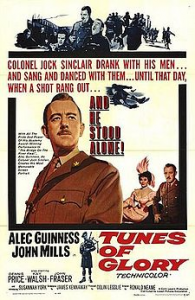 1980 Tunes of Glory filmed at Stirling Castle in Stirling, Scotland, which was the actual location where writer James Kennaway served with the Gordon Highlanders.
1980 Tunes of Glory filmed at Stirling Castle in Stirling, Scotland, which was the actual location where writer James Kennaway served with the Gordon Highlanders.
poster.
Disclaimer: The author of each article published on this web site owns his or her own words. The opinions, beliefs and viewpoints expressed by the various authors and forum participants on this site do not necessarily reflect the opinions, beliefs and viewpoints of Utah Standard News or official policies of the USN and may actually reflect positions that USN actively opposes. No claim in public domain or fair use. © John Choate
Utah Standard News depends on the support of readers like you.
Good Journalism requires time, expertise, passion and money. We know you appreciate the coverage here. Please help us to continue as an alternative news website by becoming a subscriber or making a donation. To learn more about our subscription options or make a donation, click here.
To Advertise on UtahStandardNews.com, please contact us at: ed@utahstandardnews.com.


Comments - No Responses to “December 20th Scots Book of Days. A.D. 1192 Richard the Lion Heart captured.”
Sure is empty down here...